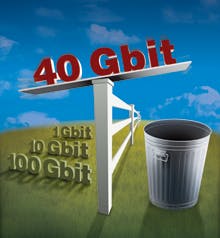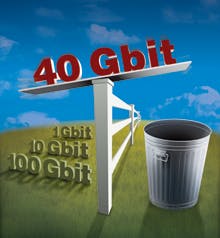But a big question remains for the Higher Speed Study Group: Should 40-Gig accompany 100-Gig down the path to standardization?
by Ed Cady
In Ottawa, Ontario this past April, an IEEE 802.3 interim meeting was held in a hotel two blocks away from the Canadian Parliament building. The Ethernet Alliance- and IEEE 802.3 committee-sponsored Higher Speed Study Group (HSSG) met to discuss proposals and vote on optical and copper link objectives. These objectives, with supporting multi-criteria data, were within the Project Authorization Request (PAR) put forth at the July plenary meeting held in San Francisco. (That meeting was held after deadline for this issue.)
The IEEE 802.3 plenary body likely will vote and authorize a task group to develop specifications for 100-Gbit/sec Ethernet links.
The multi-criteria include economic, technical, and market feasibility studies, as well as backward compatibility. The April meeting included several presentations, which proved that all criteria requirements had been satisfied. After each presentation, attendees took the floor to verbally debate, support, or critique the data shown.
High-level presentations
End-user organizations, including Google, Yahoo, and Verizon, provided plenty of evidence of their need for 100-Gbit/sec links. Some OEM members, still hurting or having painful memories of the telecommunications crash earlier this decade, drilled the network companies on how solid their forecasting really is; however, the many mega-data center giants received much less grilling due to the reality of a booming Internet market. Google representatives, for example, actually said they could use 100-Gbit/sec links immediately, and implored the start of a terabit-speed standard that they would need completed within two years.
Equipment manufacturers, including Alcatel/Lucent, Cisco, and Sun, revealed enough information about their technology and product roadmaps to demonstrate their ability to match most end users’ needs for 100-Gbit/sec links. Their products will support traditional LAN as well as newer clustered data centers, metro Ethernet, and carrier Ethernet applications.
Most server-centric OEMs, like Sun, were passionate about having a native 40-Gbit/sec Ethernet specification developed by the same task force and in the same project as 100-Gbits/sec. These evangelists want to take advantage of the serendipity of interconnecting with the 4 x 10 =40 Gbit/sec InfiniBand, Fibre Channel, PCI Express, Synchronous Optical Network (SONET), and other protocols, in a heterogeneous environment.
The most network-centric OEMs and end users were passionate about not having the two tied together in any way. These traditionalists expressed concern about spending extra capital for developing both 40-Gbit/sec and 100-Gbit/sec products at the same time and making them work together. They also pointed out that the IEEE 802.3ad Link Aggregation Standard (LAG) is being used for current 40-Gbit implementation and is fine as-is. The native 40-Gbit/sec evangelists retorted that LAG is not efficient or friendly with the other 40-Gbit/sec interfaces.
Component manufacturers, such as Broadcom and Intel, made presentations supporting 100-Gbit/sec and strongly pushed native 40-Gbit/sec. LSI’s presentation showed that their serializer/deserializer (serdes) chip technology and developing product will perform at 4 x 25=100 Gbits/sec. Sarance Technologies’ presentation promoted a much higher lane-count approach based on the InterLaken interface approach used by Cisco and Cortina. Their data showed achievable 24 x 5=120-Gbit/sec and 20 x 6.5=125-Gbit/sec implementations, but this approach was not taken seriously by the majority of the Ethernet community because it uses an unconventional coding scheme.
Other component vendors moderately pushed 10 x 10=100-Gbit/sec technologies and existing products, but again, the reaction was that too many lanes equals more cost and space. Promotions of 5 x 20=100 Gbits/sec were seen as bowing to InfiniBand and out of sync with the current four-lane Ethernet standards, such as CX-4, which is booming in the current market.
The HSSG copper subcommittee presented simulation data proving that data-center short-reach CX-4 style, twinaxial cable assemblies will work for at least 10 meters at 25 Gbits per lane. This data was based on transfer functions used in the recently approved IEEE 802.3ap Ethernet backplane standard and specification, which is for single-lane 10 Gbits/sec. Real measurement data proved that raw cables and CX-4 test boards are currently available for 25-Gbit/sec-per-lane applications. There was a lot of talk about having a new copper backplane standard for 4 x 25=100-Gbit/sec Ethernet connections.
The HSSG optical subcommittee’s presentation showed that optical transceivers will work at 25-Gbits/sec per lane and at key distances like 2, 10, and 40 kilometers for metro and carrier applications.
Tumultuous voting
Once the presentations ended, straw polls were taken to judge how well real motions and voting would go the following day. For 100-Gbit/sec copper and optical, the polling revealed consensus had been reached. For native 40-Gbits/sec, the polling showed a nearly 50/50 split, which was hardly an improvement from the previous several meetings’ straw polling.
The next day, formal voting for 100-Gbit/sec copper and optical yielded unanimous approval. The 40-Gbit/sec team held back a formal vote, hoping to gather more potential “yes” votes before the July plenary meeting. A 75% majority vote will be needed, but it appears the 40-Gbit/sec evangelists will need to restart their efforts with a new HSSG authorization and effort-which would put them out further in time for a successful conclusion.
After the tumultuous voting, I took a break and walked over to the Canadian Parliament building where I sat in the legislative hall and witnessed another frantic voting effort-this one concerning the country’s railroad network. It ended with some very happy and some very angry members shouting loudly and carrying on in front of several live television cameras. Will future Ethernet voting be broadcast live over the Internet? The answer is yes, when 100-Gbit/sec and 1-Tbit/sec Ethernet networking is in place.
Market movements
A potential Mega Data Center Consortium appeared intent on starting to drive a Terabit standard, with or without the Ethernet committee’s help. The Optical Internet Forum (OIF) 25-Gbit/sec/lane common electrical interface specification is in development phase, and the group’s efforts seem likely to mesh and liaise with the Ethernet specification development work. The Ethernet Alliance, a business and marketing consortium, will continue to help drive the 100-Gbit/sec standard work and interoperability plugfests.
The Convergence Enhanced Ethernet (CEE) Consortium is promoting the merging of InfiniBand, Fibre Channel, and Ethernet into one standard interface. Some CEE promoters are planning single chips with three cores for each interface as a first implementation. Some Ethernet backplane evangelists are seeking to replace InfiniBand, PCI Express, and SerialRapidIO in the backplane arena. Another group is starting a Fibre Channel-over-Ethernet standard effort, intended to dominate and replace the current iSCSI market and products.
Some 2 x 50=100-Gbit/sec copper transceiver chips are working in labs, but are currently too expensive for volume production. Evangelists of twisted-pair Ethernet are scratching their heads on how to accomplish 25-Gbit/sec/pair for up to 100-meter links, as they have endured a long journey in recently achieving 2.5-Gbits/sec/pair for the new IEEE 802.3an 10-Gbit standard. They have hope for carving out business in the short data-center link market, but their chips are still more costly and hotter than CX-4 components, which has resulted in them also having to offer CX-4 products. New shielded Category 6A and Category 7 cabling costs have risen close to the cost of CX-4 cabling.
Overall, work on the 4 x 25-Gbit/sec Ethernet copper standard likely will accelerate the development of a next-generation 20-Gbit/sec/lane InfiniBand specification and related products. A “birds of a feather” group appears to be positioning for a new 100-Gbit/sec Ethernet backplane specification and standard. Most of the Ethernet community wants to use the same copper and optical connectors that are on existing Ethernet standards if possible, such as SFF-8470, LC, and MPO.
Active twinaxial copper cables may be used to achieve longer-length assemblies-40 meters or longer-or the smallest possible wire gauge and outer cable diameter, because of high-performance computing and mega-data center usage. But they likely will not be specified in the 100-Gbit/sec Ethernet standard. Accumulative cable weight, diameters, and bend radius are significant issues with end users.
There is a huge scramble to partner, acquire, and merge with different companies up and down the food chain, as no one company can do it all-developing and producing 100-Gbit/sec-capable products. Highest-end simulation software and measurement equipment is expensive. New testing methodologies need to be defined and standardized. New wire termination, as well as printed circuit board connector termination and transition routing methods, are necessary to make signaling work correctly.
Very few individuals truly understand and can develop solutions that will function correctly through the entire interconnect system. But I, for one, have faith that this fifth major generation of Ethernet development will happen and will end well, as did the previous versions.ED CADY is market development director with Meritec (www.meritec.com).

